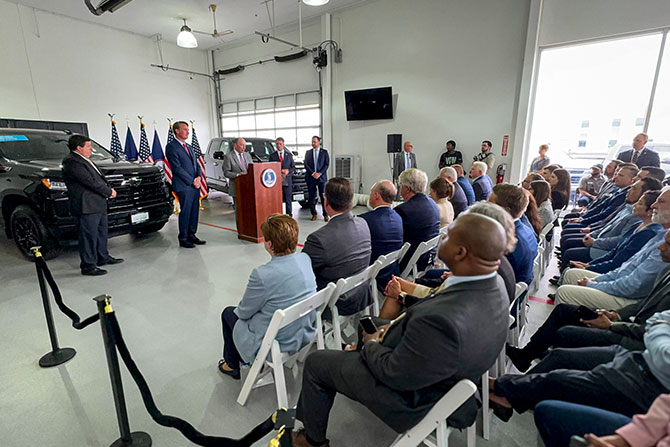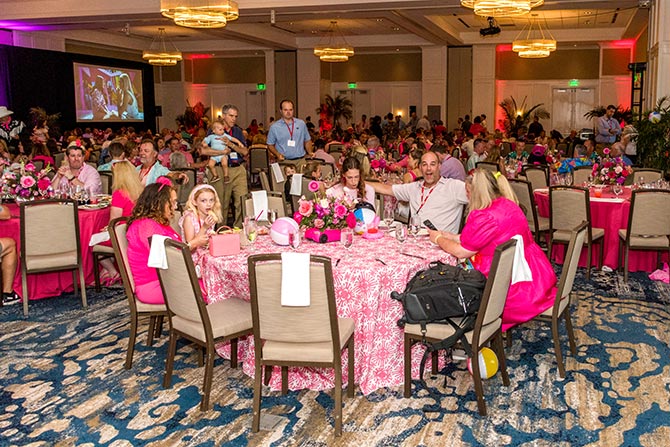Interviews are an essential but often uncomfortable experience in the hiring process — for the candidate and the hiring manager — especially if they’re more used to working in the service bay or behind the scenes at a dealership.
Between 2023 and 2027, the TechForce Foundation projects that the economy will need more than 465,000 entry‑level automotive technicians. With automotive talent in such high demand, dealerships need to do everything they can to create streamlined and effective interviews at all of their locations.
Holding effective interviews and making the entire experience enjoyable is key to keeping top talent engaged in your dealership’s hiring process, reduce the amount of no-shows to interviews, and converting to your newest hire. In this comprehensive interview guide, you can expect to understand how to run an efficient interview process through each of the three phases through action items and data-backed insights.
If you follow this advice, you’ll create an intentional approach to interviewing that empowers your dealership to follow best practices while putting the right people in the right seats at the right time.
Before the Interview
Before the interview even takes place, there are steps the hiring team at your dealership needs to take in order to attract and hire the best automotive talent possible. We’ve outlined the key tasks your team must tackle in order to optimize your process for a competitive hiring advantage.
Define Your Ideal Candidate
Your job descriptions need to pull their weight in your recruitment marketing strategy, meaning that they should do some heavy lifting in your recruitment channels. According to Hireology’s research, the number one hiring challenge for dealerships across the country is candidate quality.
With technician talent in such short supply these days, it can be tempting to rely on general job descriptions for recruitment — but this type of generalized hiring can backfire in big ways. Your job description is the first contact your dealership has with the talent pool, so you need to find a way to connect with the right people. If you can’t do that, then you likely don’t have a clear enough idea of your dealership’s ideal candidate.
You need employees who have the technical and soft skills necessary to not only fix the inner workings of vehicles, but also be able to hold conversations with customers and relay repair information. That’s why it is so important to consider your company culture and what type of person would be a good fit for your dealership before you begin writing (or generating) a job description. You can tactfully include this information throughout your job description with the words you choose; for example, you could use uplifting and encouraging terms to describe the atmosphere of teamwork that exists at your dealership at large.
Finally, you need to define the key competencies of the role that you’re hiring for. If you’re hiring for a technician position, the candidates typically need to already have their ASE certification or be willing to complete it within a certain timeframe. Alternatively, you could also advertise any apprenticeship programs you offer in your job description to recruit from a wider talent pool, if applicable.
Applicant Selection
When evaluating initial applications, it’s important to begin the process with realistic expectations in mind. While there is no such thing as a perfect candidate, you should have an idea of what you’re willing to be flexible about in your approach to applicant selection.
In order to run efficient hiring processes at your dealership, you need to remember that you can’t be completely tied to the requirements listed in the job description. Why? Data from our 2023 State of Automotive Hiring Report, only 13% of automotive job seekers meet all of the requirements in the open roles they applied for. Conversely, almost half (48%) of automotive applicants will only apply to open positions if they meet 75% or more of the requirements, so being more flexible in your applicant selection process can provide you with more candidates to choose from.
Master Interview Preparation
Before you start scheduling interviews, establish a procedure for conducting these sessions to ensure cohesiveness across all hiring managers. You can’t afford for each hiring manager to create their own interview processes, as this hinders you from being able to hire the same caliber of candidates across your dealership or locations.
When hiring managers adhere to the same interview process, however, you have a uniform standard of candidate and interview experience for hiring managers to use as their baseline for hiring.
One of the most effective ways to master interview preparation is to use interview guides to craft targeted and effective interview questions. Interview guides, like the ones available through the Hireology platform, have multiple benefits like removing bias from the interview process and making sure that all candidates are evaluated on the same criteria. While interview guides can assist in eliminating bias, it would also be beneficial to research corporate bias training to provide to your hiring managers so that you can create a diverse and inclusive workforce at your dealership.
When you have multiple people speaking to the same candidate, it’s also important that your dealership is making the best use of your and the candidate’s time — so using interview guides make sure that your hiring managers get the information they need without asking duplicate questions. If you don’t have access to pre-written interview guides, you can also use AI to generate questions to disperse amongst your interviewers too.
Address No-Show Interviews Before They Happen
Candidates suddenly dropping out of the hiring process with no warning or acknowledgment has become a common hiring phenomenon in the automotive industry. It’s so common that a term coined for dating has found a new home here: ghosting. In fact, 93% of dealerships experienced ghosting last year alone — but there are tools you can use to prevent no-shows from happening at your dealership.
First and foremost, your dealership needs to find a calendar sync tool. This tool does exactly what you think it does — it takes all of your hiring manager’s calendars to offer candidates interview appointments that work best for them. Why does this work? For starters, it eliminates the time-consuming back-and-forth rapport that arranging interviews used to require. You can send a link to your calendar as soon as you receive an application (although we’d recommend filtering candidates before inviting them to interviews).
But you shouldn’t stop there. If you truly want to cut down on the number of no-show interviews your team endures, you need to find a way to remind applicants of their upcoming interviews that doesn’t put more responsibility on your hiring team. Using a tool like Hireology’s interview reminders increases overall engagement with candidates and keeps them interested in your dealership as a potential employer. These reminders can be sent through SMS text messaging, emails or both so you make sure that your candidates see the message. We found that customers who combined our interview scheduling tool with texting capabilities increased their applicant-to-conversion rate (meaning they made hires) at double the rate of traditional recruiting methods.
Don’t believe us? Recent Hireology research found that the number one reason automotive job seekers ghost interviews is because of a lack of communication and transparency from the dealership.
Best Practices for Conducting Interviews
Surprisingly, most of the hard work for interviews occurs before and after the interview. Being organized is one of the best strategies your dealership can use to give candidates a great first impression of you as an employer.
Your focus during the interview should be on getting to know the candidate to the best of your abilities while holding a natural conversation. Take a look at the best practices we have listed to learn more about how you can conduct efficient and effective interviews to hire better candidates faster.
Hold the Right Amount of Interviews for the Role
You need the people in the door — fast. But you also need to do your due diligence to make sure you pick the right candidate for the position. In order to do this, you may need to conduct more than one interview depending on the seniority level of the position you’re hiring for. We suggest holding two interviews for roles in high demand and/or with high turnover to move as efficiently as possible. Hireology data revealed that over a third (34%) of automotive applicants want to be interviewed within 48 hours of applying, while 60% want to be interviewed within three days.
The first interview should be a simple phone screening where you give the high level overview of the job and feel the candidate out. This conversation shouldn’t last more than 15-20 minutes; you want to be able to look at the big picture of the candidate, just in case they might be good for another role you’re trying to fill. At the end of the first screening interview, be sure to close the conversation with the compensation and location information to make sure that the candidate is comfortable with what you’re offering. Just like in sales, you want to always be closing in interviewing so there are no surprises when an offer letter comes through. The second interview would be with who the candidate’s direct supervisor would be to see how they get along and get their take.
Create a Positive Interview Environment
Interviews are, by nature, anxiety‑inducing interactions. The candidate’s very livelihood could be on the line here — and that outside event can impact how they perform during the interview.
Give the candidate some grace here by doing what you can to subconsciously ease their nerves. Tips for building rapport and fostering candidate comfort during interviews include:
- Familiarize yourself with the application ahead of time and keep a copy in front of you to reference during the interview.
- Welcome them warmly with a handshake.
- Don’t dive right into the questions — keep it casual and uncover their current situation.
- Set expectations for the rest of the hiring process and how you’ll communicate during it.
- Generally treat candidates like humans with families and friends.
- Do less talking and more listening.
- Steer the conversation but don’t dominate it.
Remember: onboarding starts with the interview. It’s not unheard of for a candidate to choose a lower paying job offer within their desired salary range if they felt like it was a better cultural fit. We found that 36% of automotive job seekers would take a lower paying role within their desired salary range if it provided a good culture or working conditions. As dealers, you know better than most that first impressions matter — and when you can provide an enjoyable experience for the customer (or the candidate), you’re on your way to gaining their loyalty.
Go Beyond the Script
Just because you’re using an interview guide to make sure that your hiring managers gather all of the relevant information from candidates doesn’t mean that you have to go down the list robotically. Instead, you should ask questions during the natural flow of conversation so it feels less like an interrogation and more like a dialogue.
The questions you have in your interview guide should vary in type. You want to find out if the candidate has the technical skills and experience necessary for the role you’re filling, especially if you’re hiring for technicians. Despite this, you also need to gauge whether the candidate has the soft skills needed to handle interactions with customers. You can do this by asking a variety of behavior-based and skill‑based questions from your interview guide during the interview.
Capture Insights in Real Time
Other than steering the conversation to find out more about the candidate, your only job during the interview is to document your findings to share with the hiring manager and others involved in the hiring process. If you don’t have a way to note your findings while you’re discussing with the candidate, you run the risk of forgetting information that could help you make a decision between one candidate and another.
Taking notes in real time is extremely important so that you can make the best hiring decision for your dealership. Without these annotations, you can’t accurately give comprehensive feedback to other hiring managers. When it comes to evaluating candidates, the more information the better — so noting things like their attitude, their strengths, how you would rate them for the role in general and more can all help you make the final decision.
Post Interview Best Practices
Holding a successful interview doesn’t mean you’ve crossed the finished line just yet. Now, you need to compile your thoughts into a fair evaluation of the candidate, which can sometimes feel more daunting than the interview itself.
Block Time for Hiring Administrative Tasks Daily
Immediately after the interview, you should take 10-15 minutes to review your notes and clarify any ambiguities while the interview is still fresh in your mind. Realistically, your hiring managers should be able to plan this brief period of time immediately after the interview.
Employees who work on your hiring team should also block time in their daily schedules to complete all of the various hiring administrative tasks assigned to them instead of trying to squeeze it in when they can. This technique ensures that these critical steps actually get completed and that the employee will have the dedicated time they need to focus. Examples of tasks hiring managers could work on include updating candidate statuses or scoring candidates based on their notes from earlier.
Accurately Update Candidate Interview Status
Modern hiring platforms exist to make hiring easier and faster — but only if you know how to optimize your usage. In this case, if you want truly efficient candidate tracking and organization at your dealership, it’s crucial to track your interview statuses.
Interview status goes further than whether or not the candidate was hired or rejected; you can use these statuses to reflect on confirmation of interview invites, if the interview is in progress or completed, if the candidate simply didn’t show up, or even canceled. These interview statuses can come in handy when you’re reflecting on your various candidates’ interview statuses within leading recruitment platforms like Hireology to note whatever situation you please. With interview statuses, you can accurately track meaningful codes to reflect a candidate’s progress.
You should also use tagging features available to make searching for candidates that much easier. Instead of scrolling through all of the candidates you have for an open role, simply type in some unique identifier that you’ve flagged the candidate with to save time and move faster. This is especially helpful when you want to reach out to previous applicants who you thought might excel in a different role or if they were simply second place in the last round of hiring. Using tagging in this way can expand the pool of qualified talent you can hire from — and can potentially speed up your process overall.
Evaluate and Score Candidates Holistically
When you first sit down to evaluate and score candidates, you want to compare their answers in the interview to what your ideal candidate that you envisioned earlier would say. This keeps the evaluation fair since you’re not directly comparing them to another candidate and can unbiasedly provide an interpretation of their skills, both technical and interpersonal.
We suggest that you never score anyone over 80% if you’re the one conducting the initial phone screening, simply so you don’t give the hiring managers you pass them along to with any reason to have bias. You don’t want to influence them in any way, so scoring 80% or below lets them go in with their own expectations for the experience.
After completing this initial evaluation, it’s time to compare candidates to one another. At this step in the decision-making process, it gets down to brass tacks: who has more of the skills you’re looking for in the role? If you did your due diligence when comparing the individual to the ideal candidate, you have a pretty clear picture of what each candidate would bring to the position.
Move with Urgency
Hiring in the retail automotive industry happens fast. Considering that 61% of automotive job seekers accept the first role they’re offered — and 45% will accept the second — if you’re holding an interview and you know that this candidate would excel in the role and at your dealership, you can schedule them for the second interview immediately. You don’t want to offer the role outright, but if you have no worries about passing this individual along then you don’t have to wait any courtesy days/time period to contact them again for a follow-up interview.
Just like in sales, time kills deals. The sooner you can schedule secondary interviews or follow up in general with candidates, the better. While you want to move quickly, you still need to complete certain hiring steps to ensure that you’re making the right decision for your dealership — and that means conducting reference checks. Typically, you can do this step for top candidates before the final interview in order to speed up the process and get them on your team faster.
Keep Lines of Communication Open
Immediately after the interview, you should send the candidates a thank you message for their time and what they can expect in terms of next steps. There are more opportunities available in the retail automotive space than there are job seekers, so having the candidate show up and complete the interview is an accomplishment itself.
You can make this follow-up process much simpler for your team by using a customizable template that you just drop details into and send. This simple act keeps the lines of communication open between you and the candidate so you can continue to engage with them throughout the rest of the process.
If you choose to not continue with a candidate, it’s very important that you provide closure to rejected candidates. Make it a priority to let rejected candidates know that you’re choosing not to move forward with them within two to three days — but be kind. You might want to stay in contact with these talented workers later down the road; they could continue their education, gain more experience or be interested in a different role at your dealership when you connect with them again.
If, for some reason, the hiring decision is delayed and cannot be rushed you need to keep the candidates warm. Again, you want them to be excited about joining the team at your dealership so you can’t let stalls and hiccups make them second guess — or accept another role elsewhere.
Create a Consistent Process
All in all, you need to create a system that works best for you and the hiring team at your dealership. How you carry out these steps might differ from how the dealer down the road does it, but all that matters is that your process makes sense for you.
It is important, however, that you document the general procedure to use again in the future. Keeping all of your templates, hiring steps, job descriptions and candidates from all of your rooftops in one centralized location like an applicant tracking system makes it much easier (and faster) to get your open roles in front of job seekers the next time you have an opening.
Analyze and Optimize
As you go through your candidate ratings, comparing one to another should be easy. If it’s a close decision, you can always rely on the candidate notes from all of the interviewers for more insight on how the team feels. Sometimes that’s not enough though; in that case, you could consider scheduling one more interview with each of the two finalists. However, if you feel that no one that was interviewed met your expectations, there are two options you could take: lower your standards or consider alternative methods of advertising your open roles.
Ready To Hold Better Interviews at Your Dealership?
Interviews are a critical part of the hiring process — but it can be difficult for everyone involved in hiring to be on the same page. By creating a uniform system across your locations, you can ensure that you’re consistently hiring people at the caliber you want. Dealers that prioritize easing the interview process for candidates and their hiring teams will find the most success in the years to come.
Hireology is the leading provider of hiring software for multi-location businesses. The platform equips HR and business leaders with the support and tools they need to attract better quality talent, fill open roles faster, and make data-driven hiring decisions. Hireology was rated No. 8 on G2’s 2023 list of 50 Best HR Products.
With focused expertise in the retail automotive industry, 1 in 4 dealerships nationwide rely on Hireology for their hiring, HR and payroll needs, putting people at the center of their organizations. For more information, visit hireology.com.








